NVIDIA's GeForce GTX 560 Ti w/448 Cores: GTX 570 On A Budget
by Ryan Smith on November 29, 2011 9:00 AM ESTPower, Temperature, & Noise
Last but certainly not least is our look at power, temperature, and noise. If we’ve clearly established that the GTX 560-448 has more in common with the GTX 570 than the GTX 560 Ti in gaming performance, then let’s see if the operational attributes are equally close.
| GeForce GTX 500 Series Voltages | ||||
| Ref 580 Load | Ref 570 Load | Zotac 560-448 Load | ||
| 1.037v | 1.025v | 1.000v | ||
Looking quickly at voltage, our Zotac card is set to 1.0v. This is actually 0.025v less than our reference GTX 570 and GTX 580 cards, though it’s important to note that all of these cards have a wide VID range. Realistically speaking we expect that the GTX 560-448 would have a similar to greater VID range than the GTX 570.
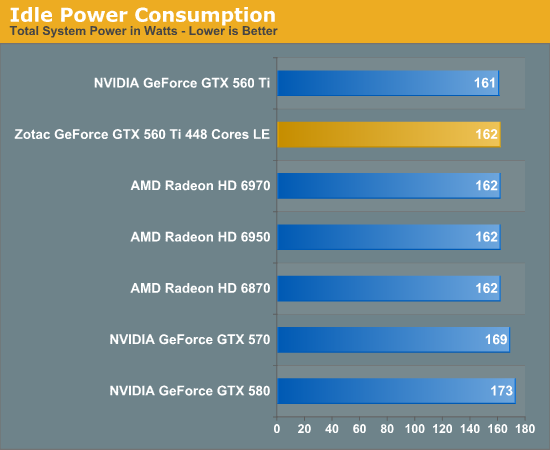
It’s quite interesting to find that idle system power consumption is several watts lower than it is with the GTX 570. Truth be told we don’t have a great explanation for this; there’s the obvious difference in coolers, but it’s rare to see a single fan have this kind of an impact.
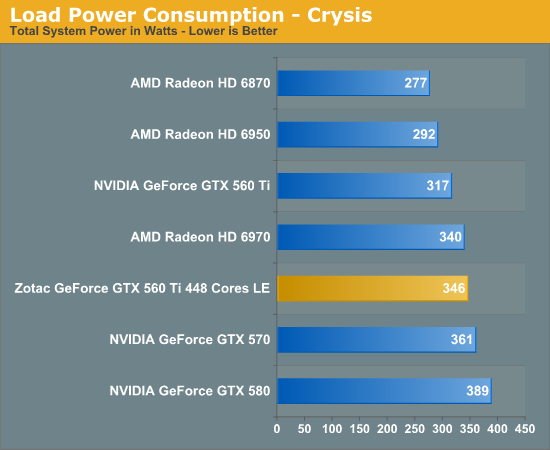
Power consumption under load shows a similar benefit. With the Zotac GTX 560-448 we’re drawing 15W less than with the reference GTX 570. Given that the performance of the Zotac GTX 560-448 is so close to the GTX 570, and this actually starts looking like a cheaper GTX 570 with lower power consumption, which is not something we would have expected to find. But at the same time this means load power consumption is still nearly 30W greater than the GTX 560 Ti, is a very distinct difference for two products sharing the same name.
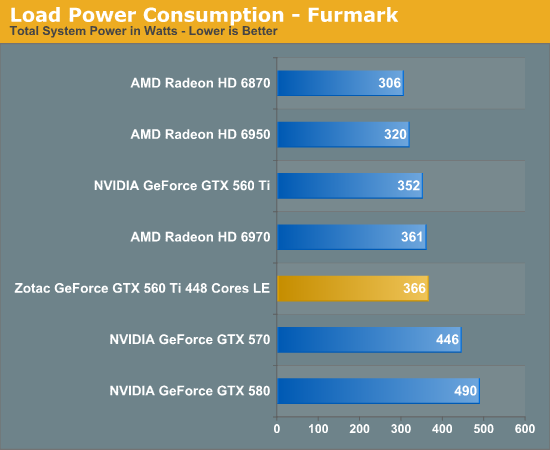
FurMark is thrown in for consistency, but at this point NVIDIA’s driver throttling is so extreme that FurMark is instantly beaten back when started.
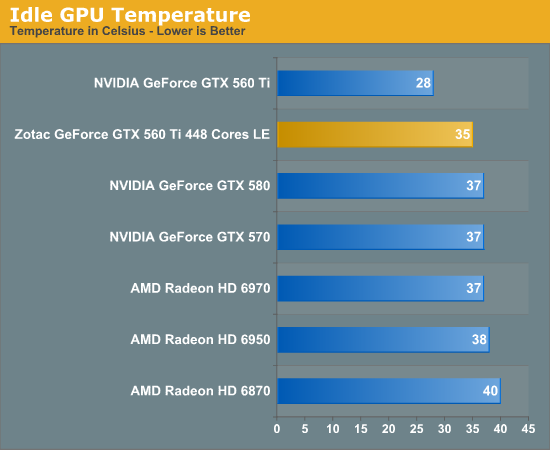
When it comes to GPU temperatures, idle temperatures straddle the difference between the GTX 560 Ti and the GTX 570. The open-air cooler is usually better for lower temperatures, but at the same time GF110’s higher idle power consumption negates some of this benefit. In any case it’s still one of the coolest high-end cards at idle.


Meanwhile GPU load temperatures are at the middle of the pack. Like all GF110 products the Zotac GTX 560-448 starts getting toasty under load (even with the open-air cooler), but it’s still noticeably cooler than the GTX 570 and GTX 580. With that said the open-air cooler means that this is going to be case-dependent, so cases with poor airflow would favor the closed coolers of the GTX 570 and GTX 580.
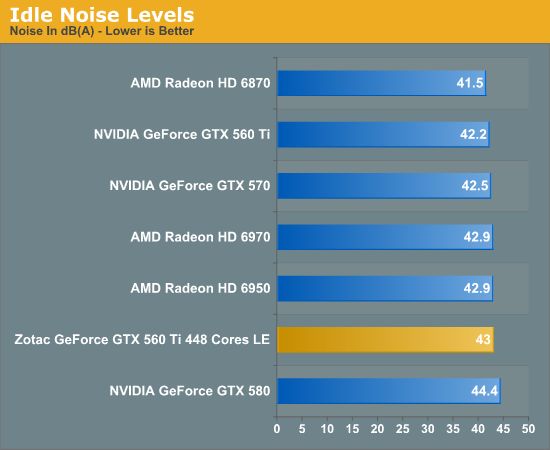

Finally we have our look at noise. The Zotac GTX 560-448 idles just a hair louder than most of our other high-end cards, including the GTX 570. Under load however that open-air cooler really makes its mark among a crowd of closed coolers, leading to noise levels little above the GTX 560 Ti and remarkably quieter than the GTX 570. On a performance/noise spectrum this is fantastic, but the devil is in the details: you need a case with good airflow to make this happen. Otherwise the Zotac GTX 560-448 ramps up significantly once temperatures approach 90C.










80 Comments
View All Comments
Transmitthis14 - Tuesday, November 29, 2011 - link
Many would ignore "Value" like that.I use Premier and Pshop, (cuda Acceleration) and also like the option of Physx with my Games when coded for.
So A 6950 then becomes a none option
Exodite - Wednesday, November 30, 2011 - link
Fringe benefits like those swing both ways though.I need three simultaneous display outputs, which render Nvidia options redundant in much the same way.
Looking strictly at price/performance, which is the metric most consumers would use in this case, the 2GB 6950 is indeed an excellent option.
grammaton.feather - Wednesday, November 30, 2011 - link
Oh really?http://www.overclock.net/t/909086/6950-shaders-unl...
I also agree with the CUDA argument. I have used Nvidia for years because of stereoscopic 3d support, more recently CUDA and PhysX and because I don't have driver crashes with Nvidia.
ATI may be better value for money at the cheap end of the spectrum, so long as u don't mind driver crashes.
A friend who used his high end PC for business had 170 plus ATI driver crashes logged by windows. I chose an Nvidia GPU for him and the crashing stopped.
rum - Wednesday, November 30, 2011 - link
I have had nothing but ATI cards since the 3870, and have NOT experienced these driver crashes you are speaking of.I use my computers for gaming and computer programming, and sometimes I do actually stress my system. :)
I am in the process of evaluating my video needs, as I do need a new video card for a new PC. I won't blindly go with ATI, I will EVALUATE all aspects and get the best card for the MONEY.
I don't need cutting edge, neither do most people, and we do evaluate things on most bang for the buck.
VoraciousGorak - Wednesday, November 30, 2011 - link
Funny, since I Fold on a GTX275, GTX460, and 9800GT on two different systems, and pretty often have NVIDIA's drivers lose their minds when finishing a WU, shutting down the system, or while simply processing a WU. I've tried multiple WHQL and beta drivers and settled with these being the least of my problems (the worst being total system unresponsiveness while Folding and a hard reset after a client stopped.) However, when I folded on my 6950 (granted, different client, but I Folded on it with the Beta client too) it never had a driver freakout, screen blank, or even a flicker when turning on or shutting off WUs.It seems to me that people that have major driver issues with AMD (not ATI anymore, by the way) cards are outliers, relative novices, and/or are using very outdated drivers or are recounting stories back from when the ATI 9700 series were new. I'm probably an outlier as well with my NVIDIA gripes, but characterizing a major modern GPU manufacturer with constant widespread driver issues or stating that any GPU is guaranteed to have problems is just silly.
silverblue - Thursday, December 1, 2011 - link
Oddly, those people who slate AMD are the ones who never ever seem to have an NVIDIA crash, or at least won't admit to one.Gorghor - Thursday, December 1, 2011 - link
I know this has no technical relevance, but I thought I'd share since my first reaction when I saw the article title, was "did I make a mistake buying an ATI6950?"For some reason I have been sticking to nVidia cards since the days of the Geforce 2. I made an exception with the ATI 9800 and although the performance was good back then, I had many problems with the drivers and really didn't approve of the catalyst control center.
When I upgraded my mainboard to the Sandy-bridge generation, I left my "old" GTX285 in the system and had several daily crashes related to the nVidia drivers (even after several months and driver updates).
About a month ago I decided it was time for me to upgrade the graphics. I wanted to stick to nVidia albeit the problems with my GTX285, but the price/performance ratio was just unacceptable when compared to AMD cards. I chose the ATI6950 2GB considering the same money would barely get me a GTX560.
I have to say I'm impressed. The performance is truly exceptional, even with no shader unlock, the catalyst interface has really matured over the years and my crashes are completely gone. So as far as I'm concerned, blindly going for nVidia is not an option anymore.
Golgatha - Tuesday, November 29, 2011 - link
what I take away from this review is the 560-448 is pretty much on par with a stock 570, but it will only be manufactured for roughly 2 months, and then be discontinued. Why would any gamer buy this card when they can get a superior card within $20 of this one and pretty much be guaranteed availability if they want to run SLI? Also, what's with the power connectors on the rear of the card. All of these long cards should situate those connectors on the top of the card.jigglywiggly - Tuesday, November 29, 2011 - link
I'd avoid it, you will probably be screwd with drivers in the long run.Samus - Tuesday, November 29, 2011 - link
As far as drivers and modern games go, people with ATI hardware have been having substantially more problems in Battlefield 3. Then the issue of microstutter arises which barely affects nVidia hardware, for what can only be presumed to be a ATI driver problem. Lastly, many people have experienced PowerPlay problems with Radeon 4000-5000 series cards running newer drivers due to clockspeed changes in-game, sometimes causing BSOD's, but always causing performance problems.nVidia has been, and always will be, the kind of drivers. The days of Mach64 still plague ATI's driver developement team. nVidia invented unified drivers and changed the game for the industry. They update their SLI profiles more than twice as often as ATI does for Crossfire, which alone shows their loyalty to their SLI users.
ATI has the hardware engineering team. That's clear. They can produce faster cards that use less power at lower prices. But you will NOT get superior drivers by a longshot.